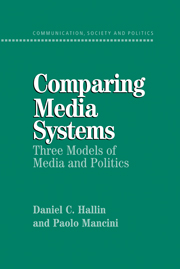Book contents
- Frontmatter
- Contents
- List of Figures and Tables
- List of Acronyms
- Preface
- 1 Introduction
- Part I Concepts and Models
- Part II The Three Models
- 5 The Mediterranean or Polarized Pluralist Model
- 6 The North/Central European or Democratic Corporatist Model
- 7 The North Atlantic or Liberal Model
- Part III The Future of the Three Models
- Bibliography
- Index
6 - The North/Central European or Democratic Corporatist Model
Published online by Cambridge University Press: 05 September 2012
- Frontmatter
- Contents
- List of Figures and Tables
- List of Acronyms
- Preface
- 1 Introduction
- Part I Concepts and Models
- Part II The Three Models
- 5 The Mediterranean or Polarized Pluralist Model
- 6 The North/Central European or Democratic Corporatist Model
- 7 The North Atlantic or Liberal Model
- Part III The Future of the Three Models
- Bibliography
- Index
Summary
What we call the Democratic Corporatist Model developed Northern and Central Europe – in Scandinavia, the low countries, Germany, Austria and Switzerland. Like the Mediterranean countries, those we discuss in this chapter are geographically proximate, and like each of our three groups of countries they have a history of frequent and intense social contacts, in this case often marked by strife. In terms of language they are diverse, though they include three countries with large German-speaking populations, and Dutch, Norwegian, Danish, and Swedish are closely related to German, which, along with English in a later period, has served as lingua franca in the region.
The exchange of experiences and the mutual influence of cultural and political models has been particularly strong within certain groups of countries – among Austria, Switzerland, and Germany, among the Scandinavian countries, and between Belgium and the Netherlands; but a strongly intertwined historical evolution has affected the communication system across the whole region. The interaction of these countries has often been conflictual in character. But conflict too is a social relationship, and has often meant exportation or mutual influence of cultural models. As we shall see, the “colossal war of religious propaganda” (Anderson 1983) that was started by Luther's challenge to the Church played a particularly important role in creating a common culture and a common public sphere in Northern and Central Europe: it shaped not only religious beliefs but political structures and media practices, including the fact that, across the region, the emerging print media became vehicles for expression of deeply rooted, conflicting political and religious subcultures.
- Type
- Chapter
- Information
- Comparing Media SystemsThree Models of Media and Politics, pp. 143 - 197Publisher: Cambridge University PressPrint publication year: 2004

